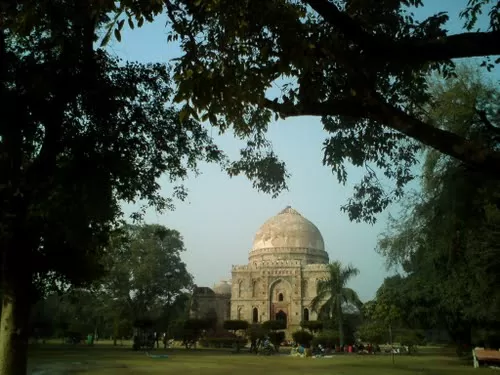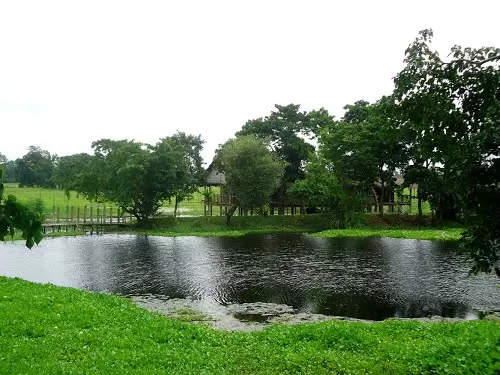







Vypin Island is criss crossed by canals. Though the area nearer to mainland is now waiting to see a boom in construction of multi storey buildings, the island and its beaches still have a serenity and beauty which is becoming rarer by the day. Standing in front of a noisy school on the bank of the backwaters, one could see a school of dolphins popping in and out while a few fishermen were busy catching fish, standing right on the bank. Dolphins and fish seem to move together and the alert fishermen lower the Chinese nets into the water to pick up whatever fish can be netted. Not a very effiecient way, but then interesting to watch.

Kovalam beach is a favourite with tourists for swimming in the sea. There are coast guards around who keep a watchful eye. The beach is advertised as 'jelly fish Free' on the various travel sites. So it was a surprise to find large number of purple jellyfish being washed onto the shore by the waves. The coast guards assured us they are dead and harmless. The fishermen throw them out when they get caught in their nets. It seems there is a migration of jelly fish for about a fortnight in October, when the sea gets foamy with the gelatine in the jelly fish. Kovalam beach never fails to arouse curiosity!

The weather was good. It had rained for two days so the drive up was picturesque. We stopped the car many times just to take in the scenery. On the way we passed many other cars doing the same. Ha! this is like heaven after the hustle bustle of daily life. View of Chandigarh from half way up Morni Hills, on the Shivalik range. Lush green creeper, the leaves of which are used for making leaf plates(patthal) " Nature Camp, Forest Department" My husband noticed the board. Shall we check this out? But then we cannot make it to the top which is still 12 km away. Remember we need to go back by evening." A quick decision was made -nature camp it is. After all Forest Dept would have selected the most scenic spot on the hill, I reasoned. It was a scenic spot. On top of a small hill surrounded by nurseries for trees and freshly planted variety of trees. The thatched roof dining hall looked inviting. The stilted huts reminded us of the tourist huts we had seen in the islands of South Korea. The carefully tended nursery at nature camp. We decided to take a different route back to Chandigarh. A short cut from the other side of Morni Hills. A road not well developed and full of potholes. Each pothole reminded us of the reality of our country's serious efforts to preserve the pristine. The roadside was dotted with trucks and stone crushers for miles on end. The houses and slum dwellings seemed to have just one focus-cutting the mountain, mining the stones and crushing them.

"Auli has the best slopes in the world facilitating snow skiing during winters beginning January to the end of March." My friend and I were looking forward to seeing the International skiing festival organized in February every year. 'Snowfall predicted for 24 Feb 2009, temperatures expected to fall below -12 degrees' my brother looked up some weather forecast on the Internet and warned me before I boarded the train.As we drove up through steep, dusty and winding roads, the peaks Nanda Devi, Kamet, Mana parbat and Dronagiri began to look closer and closer. The landscape looks a bit like Leh with brown rocks all around -Leh in summer that is, my friend observed. The snow tipped Nanda Devi was tantalizing, I forgot we had come to see snow and the skiing festival. The trees and plants one sees above 10,000 feet surprise you with their sturdiness. The trees look majestic and protective. The sturdy bushes and grass support your heels while climbing up. Pretty flowers smile at you lighting up unknown corners. Trekking on foot is the best way to appreciate the terrain and the flora. Here is a Basant tree with Nanda Devi in the background. The tree is having flower buds in February. Normally at this time it will be covered with snow. We found beautiful flowering trees lining the roads on our way back to Joshimath. We wanted to know the name of the tree. Some Bank officials whom we met, who were posted in the area, could not help. Nor could the hotel owner at the hotel where we had lunch. The most common local tree had no name! I had seen the same flowers in Mandal (on the way to Kedarnath) a few years back. Here is a photo of the tree in Mandal. The flowers resemble cherry blossoms.

Mirza Asadullah Khan Ghalib, is the most well known Urdu poet of the Indian sub-continent. His ghazals and poems reflected the difficult times he lived in-the 1857 revolution, the transition of power from Mughal empire to the British empire. He was one of the celebrated residents of the walled city. The heritage walk, led by Ms. Surekha Narayan began at the Town Hall in Chandni Chowk and the first stop was Ghalib's haveli, acquired by the Delhi Government in 1999 and restored as a museum to Ghalib. The walkers passed through Ballimaran bazaar and witnessed Mahal Sara, the haveli belonging to Umrao Begum, Ghalib's wife. It has now been converted into Rabea Girls' School. The walk culminated at Rabea Girls' School where the students enacted a "mushaira" in the "durbar" of Bahadur Shah Zafar.

I visited Kashmir for the first time in August 2006. The tender beauty of Dal lake in the morning, the cheerful Lidder river en route to Pahalgam and the majestic fir trees in Gulmarg- add to it a very hospitable people, and one wonders if Kashmir is cursed for possessing too much beauty. The presence of army at every 100 meters or so in Srinagar, too many restricted areas and the dead silence of the roads after nine pm or so, tells you things are not normal in Srinagar. Our tour organizer, http://www.indianwildlifeclub.com/EcoTourism/Discovery-Journeys.aspx made sure that we could make the most of our trip by organizing stay in the elegant but grand houseboat called “ Lotus Retreat” and arranging for all transport in and around Srinagar, taking care of all permissions etc. Seeing how silk is extracted from silk worms in a traditional factory, catching rainbow trout in a government sponsored center at Pahalgam, seeing the grey langurs in Dachigam, the laughter of the Lidder-these are memories I will cherish for ever.

The Taj Mahal is considered the finest example of Mughal architecture. This marble edifice is a mausoleum located in Agra, India, built by Mughal Emperor Shah Jahan in memory of his favorite wife, Mumtaz Mahal.
In 1983, the Taj Mahal became a UNESCO World Heritage Site.
Building of the Taj began around 1632 and was completed around 1653, and employed thousands of artisans and craftsmen. "The sight of this mansion creates sorrowing sighs;
And the sun and the moon shed tears from their eyes.
In this world this edifice has been made;
To display thereby the creator's glory." -Emperor Shah Jahan

Lodhi Gardens in New Delhi was landscaped in 1930 by Lady Wellington. The park is a favourite with morning walkers and yoga enthusiasts. The park also houses heritage monuments of the Lodhi era, remnants of the decorated walls of these structures taking us to a period in history when rulers spent money and labour in creating tombs and mosques. Intach ( Indian National Trust for Art and Cultural Hertage) organizes heritage walks in the Gardens regularly.

Majuli in upper Assam is the largest river island on the Brahmaputra River . It is a pollution free fresh water island. Total area of the island was 1250 sq.km., now it is about 650 sq.km, having lost significantly to erosion. Only 26 percent of total land area of Majuli is suitable for cultivation. In the 16th century a sage called Shankardev founded a new sect of Vaishnavism here, which has flourished healthily in the last five hundred years. Today, the ‘sattras’ play a major role in the religious and social lives of every inhabitant of Majuli. Every family sends one son to be a monk, usually from the age of six; the belief is that if one son becomes a monk, then the whole family will be blessed by God. With pilgrims flocking here every year in numbers matched only by the migratory birds for which the island is also a haven, Majuli is known in some circles as the ‘Vatican of Vaishnavism’. Performed by the monks of the Bhogpur Sattra at the Birla Mandir, New Delhi on 20th February, 2010, the dance clip below, has no song or words but strangely resonates with the uncertain future of this island. The island today is separated from the mainland of Assam by 2.5 KM. Apart from the ferry connecting Majuli to mainland, an “e-Sethu” or e-governance project of Government of India connects the village to Assam. A wetland, Majuli is a hotspot for flora and fauna, harbouring many rare and endangered avifauna species including migratory birds that arrive in the winter season. Among the birds seen here are: the Greater Adjutant Stork, Pelican and Whistling Teal. The island is almost pollution - free owing to the lack of polluting industries and factories and also the chronic rainfall.


